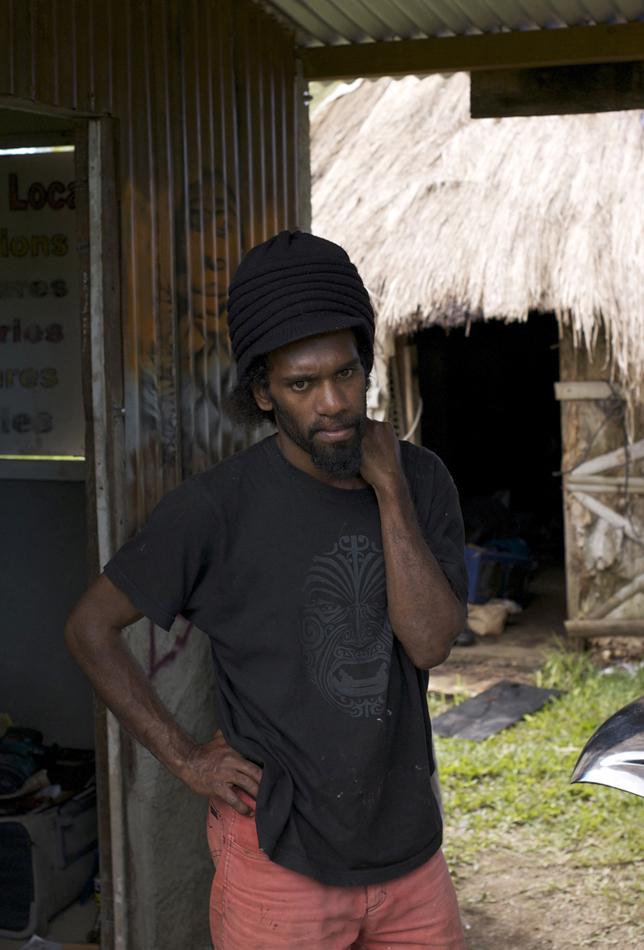A Visit at Ilie Poindipenda’s Studio

Ilie, a 24 years young artist from the Tiéti tribe in Poindimié on New Caledonia’s east coast, is one of the new Caledonian representatives at the upcoming Festival of Pacific Arts on Solomon Islands in July 2012.
Reggae music is greeting me as i arrive at Ilie‘s place. Ilie appears between a traditional Melanesian hut and his home and studio. Smilingly he invites me in, offering coffee and delicious sweet bananas from his garden.
He prefers natural materials like wood, Ilie observes. Yet, we sit amidst sprayed corrugated metallic walls and hoods. A technique he learned from his elder brother.
Art harks back to his grandfather, he explains. All (note: male) members were and are artists, mostly working in wood sculpture and drawing. Ilie is the only one, who combines several mediums and also expresses himself in music. He is member of the Jemââ formation, a group that is divided into seniors and juniors. Jemââ, Ilia illustrates, means “history” and transports tradition from his ancestors to the younger generations and will be delivered to his sons one day. It is Kaneka, the revival of Kanak music infused with genres like reggae, jazz and blues.
Like in his music, Ilie traces ancient tales and histories in his art. As if in horror vacui, history and mythology fills the space of his drawings. The three-dimensional sculptures around his and his family’s property likewise absorb their surrounding territory. Art reveals the endlessness of a continuum, significantly embodied in the adjunct traditional Kanak ‘case’ of his deceased grandfather. The latter embraces the awareness and the deep respect for passed life-periods and their forth-going presence. serving Ilie as a storage and working space, his grandfather’s items such as the prominent chair in the corner, remain. Ilie insists, is not allowed to throw away his grandfather’s belongings. “They have to ‘die’ naturally,” rotten, compost and vanish.
Ilie‘s first exhibition was held in New Caledonia’s capital Nouméa, where he was resident at the Tjibaou cultural center. His works are traveling throughout the country now. Yet it will be Ilie‘s first time to board a plane in July. Broadening his knowledge on airbrush and photoshop at the multimedia school in Koné, he will be presenting different live performances at Solomon islands for over a month. As he admits, he accepted the invitation, “mostly because of the animals.” After watching a documentary on the Solomonian plethora of fauna, he was curious about the biodiversity. He concludes, “I love animals.” It is the easiness of savoir vivre, fishing, hunting and planting, “everything with respect to nature,” Ilie emphasizes. With disgust he mentions a broadcast on cruel asian fishing practices he saw the other day. However, no signs of ecological or environmental messages are present in his works. such topics seem not appropriate to enter the stage of visualization as family members work in sectors being held responsible for environmental problems. Flora and fauna serve the visual transportation of stories, myths and history that capture life, transmitted through oral tradition.
I am thus interested in artistic exchange and practice. Yet ‘social networking’ encompasses different meanings and dimensions. Friends and artists help one another when need is demanded, Ilie remarks, family transports materials from 300km away capital city to facilitate his work. The internet remains an information and inspiration source. An ocean breeze catches my nose. Being few steps away from the blue sea, surrounded by dense vegetation, I wonder, “what is your working routine? are you working everyday?” “No,” Ilie answers briefly, “only when the sun is shining.” I am amused, “What are you doing when it is raining?” Ilie laughs, “watching tv.” “Inspiration,” he reveals, “derives from weather and music.”
dominika glogowski / interview with ilie poindipenda – 9 june, 2012
copyright is owned by artEC/Oindustry


